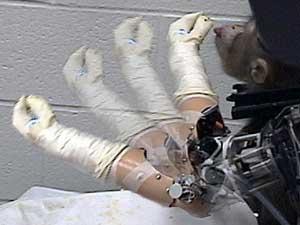Bionic Apes: Holy Shit!!!
I was listening to Stern this morning (Artie was not in...and yesterday there was some talk about him possibly leaving the show at some point...that would suck...) and because I was delayed due to an accident on the highway, I got to hear the news...It seems that a very convincing seated female robot has recently been developed by a Japanese fellow.

(click image for source and more info)
I was curious as to how it looks and moves...It looks a lot like a real doll but I haven't seen any footage of it moving yet...
So anyway, while I was looking it up, I stumbled upon the following bit of news (which has been copied here from original source...link to the source by clicking the title or the copyright info below):
Monkey Thinks Robotic Arm into Action
Brain impulses translated into 3-D manipulation University of Pittsburgh
University of Pittsburgh
A time-lapse photograph shows a monkey raising a piece of
zucchini to its lips using a thought-controlled robotic arm.
The monkey's real arms are restrained.
By Michael Schirber
Updated: 10:29 a.m. ET Feb. 18, 2005
Robotic arms used by amputees are typically controlled by moving some other part of the body, like the opposite arm. Researchers would like to make such prostheses respond to the whim of the brain.
Now it turns out researchers have found a method so easy (well, relatively so) that a monkey can do it.
In a new study, a monkey fed itself using a robotic arm electronically linked to its brain. The work was presented here Thursday at the annual meeting of the American Association of the Advancement of Science.
The robotic arm is about the size of a child’s, with a fully functional shoulder and elbow, as well as a simple gripper that can hold a piece of fruit or vegetable.
"It moves much like your own arm would move," said Andrew Schwartz from the University of Pittsburgh.
The monkey’s real arms are restrained in plastic tubes. To control the robotic arm, 96 electrodes — each thinner than a human hair — are attached to the monkey’s motor cortex, a region of the brain responsible for voluntary movement. Although there is an area of the cortex generally associated with arm motion, the exact placement of the electrodes is not crucial, Schwartz explained.
"You don’t have to be exactly right because the brain is highly plastic," he said, referring to the fact that the brain will rearrange its structure to get things done. And food, it turned out, was a good motivator for the adaptable primate brain.
Computing intention
The electrodes measure the firing rate of a single neuron. Each one of the billion or so neurons involved with arm motion is thought to have a preferred direction. There is, for instance, a set of neurons associated with moving the arm up, or down, or to the right.
With a special computer algorithm, the researchers are able to find an average direction from the small sample of neurons being measured. This average direction is used to move the robotic arm.
Rob Kass from Carnegie Mellon University, who was not involved in the new study, said this type of algorithm has been around since 1960. The computational shortcut has had a wide range of applications, including missile tracking and navigation.
"The benefit of the algorithm is that it allows for a more efficient use of data," Kass said. "It also provides a framework for learning."
This learning was evident in the fact that, with practice, the monkeys became faster with the robotic control. The researchers also found that their subjects could adapt to different placements of the food.
"Our algorithm is not exactly what is going on in the brain," Schwartz said. But the monkey’s brain actually adapts its neural signal to be closer to the algorithm. The reward for this rewiring is the snack.
Interestingly, in the beginning, the monkey’s restrained arms would twitch — as if they were trying to reach and grab the food. But after a day with the robotic arm, the monkey was completely relaxed.
"He no longer was trying to move his own arms," Schwartz said.
Next up: realismSchwartz and his collaborators plan to move beyond the simple two-pronged gripper to a more realistic hand with fingers.
"That’s where we want to go next," he said. "We will need to connect electrodes to 50 or 100 more neurons — we think."
The research may one day lead to permanent artificial prostheses for those who have lost a limb, and it might also increase the mobility and dexterity of those suffering from spinal cord injuries or nervous system disorders, like ALS.
"We hope to move to human subjects in two to four years," Schwartz said.
A big hurdle, however, is the fact that biological material builds up around the electrodes, causing the signal to degrade over time. On average, the electrodes in the monkey brains only lasted six months. More biocompatible materials, as well as devices that transmit their signal without wires, may be needed to make the jump to humans.
© 2005 LiveScience.com. All rights reserved.
I really don't know what to say about this right now, but I thought I'd share it with any reader(s) who might find it interesting...I thought it was pretty cool. Imagine Doc Oc-type Ape soldiers on patrol...That'd be sweet...(Not really, I guess...I'd probably shit myself...but it'd be cool for a movie or comic maybe...).
 (I put together this image to demonstrate how cool it could be...)
(I put together this image to demonstrate how cool it could be...)
That is all.
Your Pal,
Zambo.


3 Comments:
I can see it now: Chimpbot, a robotic chimpanzee pimp that will fuck you up if you disrespect. He would have no problems keeping the bitches in line:
"Where my money at, beeyetch?" says Coco the chimpbot in a Stephen Hawking-like computer-generated voice.
"Getcho raggedy monkey ass outta my face, Coco, I only been on the street fo' 2 hours..." replies Petunia, a streetwise woman of the night.
"Bitch, I done told ya I won't abide no backtalk..." It's a computer voice, but somehow we can sense the rage lurking underneath...
And then the screams as cute little monkey paws turn into table saws and ginsu some poor ho.
Life on the street ain't no joke.
I'm having thoughts about the cute Asian sex droid as we speak. ...
That ain't no robot. I had sex with that girl. She would just lie there all submissive like and do whatever I'd say. I guess it is an accurate depiction of your average jap female.
Post a Comment
<< Home